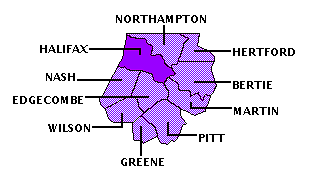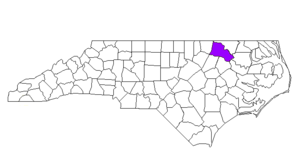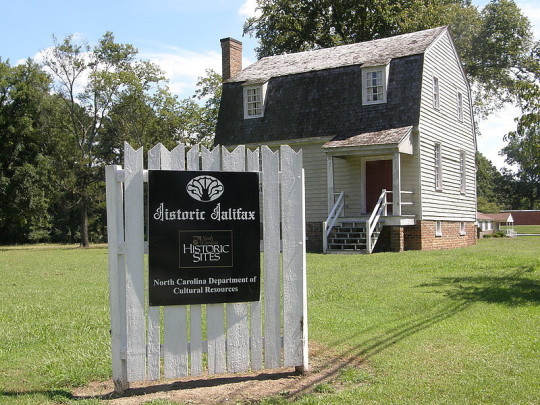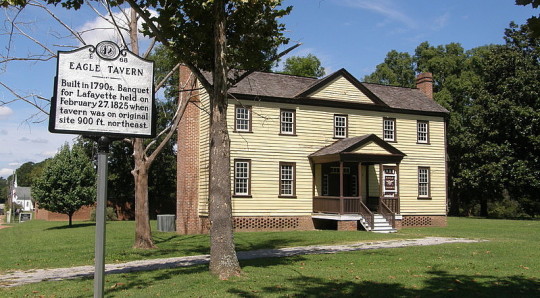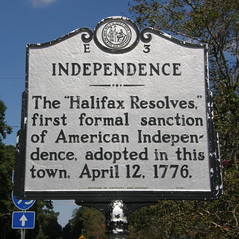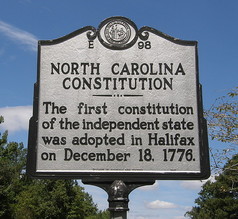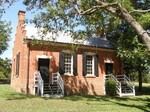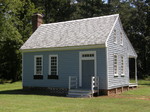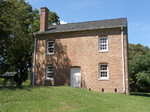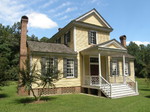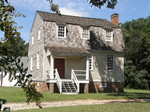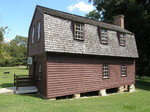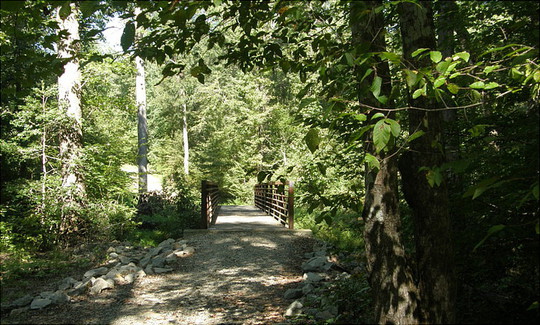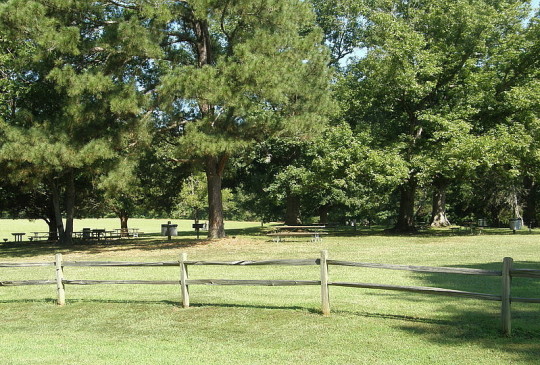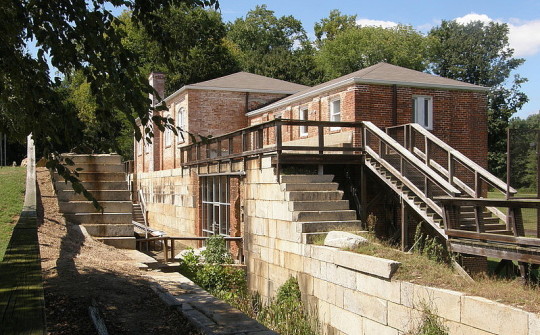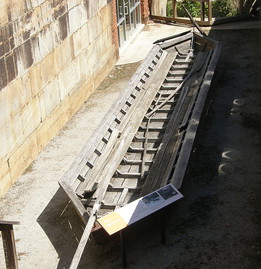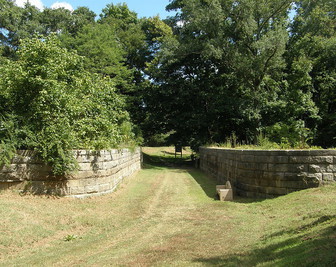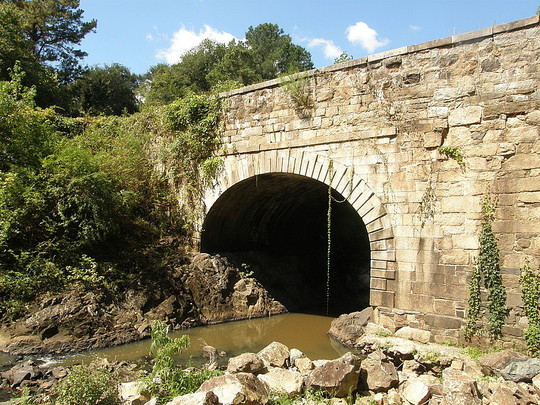HALIFAX COUNTY
Scroll down this page or click on specific site name to view features on the following Halifax County attractions/points of interest:
Historic Halifax State Historic Site, Medoc Mountain State Park, Roanoke Canal Trail and Museum, Sylvan Heights Bird Park
Fast facts about Halifax County:
Created in 1758, the county is named for George Montagu, second Earl of Halifax and president of the British Board of Trade and Plantations.
The county seat is Halifax. Other communities include Enfield, Littleton, Roanoke Rapids, Scotland Neck, and Weldon.
Halifax County’s land area is 725.36 square miles; the population in the 2010 census was 54,691.
It is worth noting that Halifax was host to both North Carolina’s 4th and 5th Provincial Congresses. On April 12, 1776, the 4th Provincial Congress unanimously adopted the “Halifax Resolves,” instructing the North Carolina delegates attending the Second Continental Congress in Philadelphia to vote in favor of declaring independence from Great Britain; the 5th Provincial Congress, meeting in November and December, 1776, adopted North Carolina’s first state constitution and elected Richard Caswell as the state’s first governor.
Below: Historic Halifax invites guests to learn more about North Carolina's rich heritage
Halifax
Historic Halifax State Historic Site helps preserve an important part of North Carolina history. Although a quiet little village today, Halifax was a bustling river port during colonial times. Numerous events placed the province of North Carolina at the forefront of the fight for independence, none more meaningful and memorable than what occurred in Halifax in April, 1776. After Provincial Congresses were held in New Bern and Hillsborough in 1774 and 1775, Halifax hosted the 4th Provisional Congress that convened in April, 1776. By this time, the divisions that threatened to separate Great Britain and her colonies could no longer be bridged.
Shots had been fired and mortal wounds suffered at Lexington and Concord nearly a year earlier, and preparations for war were being made throughout the colonies. In North Carolina, militia under Richard Caswell and Alexander Lillington in February, 1776 won a crucial victory against Scottish Highlanders who had been marching from Cross Creek (today’s Fayetteville) to Wilmington. Had the Highlanders been successful in joining British Regulars arriving by ship, Royal Governor Josiah Martin might possibly have maintained control of the colony. The Highlanders’ defeat at Moore’s Creek Bridge instead served to embolden those who favored radical action.
Supported by delegates from Mecklenburg County, which had endorsed a local call for independence on May 20th of the previous year, the 4th Provincial Congress resolved that its representatives at the Second Continental Congress in Philadelphia should join with the delegates from other colonies in declaring independence. In so doing, North Carolina became the first colony to openly call for separation from Great Britain. The “Halifax Resolves” were adopted April 12, 1776, and this date has since been commemorated on North Carolina’s state flag and state seal. Appropriately, Cornelius Harnett, the individual credited
with authoring the Halifax Resolves, gave the first public reading in North Carolina of the national Declaration of Independence from the steps of the Halifax courthouse in August 1776. Halifax served as host to the 5th Provincial Congress in November, 1776. The most important action taken by this body was the drafting and adoption of North Carolina's first state Constitution. This Congress also elected Richard Caswell as the first governor of the State of North Carolina.
Historic Halifax has been maintained and operated as a state historic site since 1965. Since a number of buildings are open to the public, four separate guided tours are offered. One features the 1760 home of prominent businessman George Owens Jr.; a second showcases the “Sally-Billy House,” an antebellum plantation home circa 1808; the third includes the 19th century jail, the Burgess Law Office, the County Clerk’s office, the Eagle Tavern, and the excavation site of the Joseph Montfort home; the last is of the Tap Room, the only survivor of more than a dozen such pubs that served the town during its heyday. The visitor center has a small museum containing a surprisingly large number of artifacts and exhibits, and a slide show relates the past and present of the Halifax community. The state historic site is open 9-5 Tuesday through Saturday. Specific tour times are posted for each of the tours described above. All tours are free of charge. 252-583-7191
Southwest of Roanoke Rapids
Medoc Mountain State Park is a 2,287-acre site in central Halifax County. Despite its name, visitors won’t find anything approaching the heights common in the western part of the state. At its summit, Medoc Mountain is only 325 feet above sea level, so it’s more aptly described as a small hill than a mountain. Still, located as it is near the North Carolina fall line, where the hard rock of the foothills yields to the softer stone of the coastal plain, the granite outcropping, survivor of millions of years of erosion, is an unusual feature in the region. In the first half of the 19th century, Sidney Waller owned much of the land around the present day state park. Weller cultivated grapes, was largely responsible for implementing the American system of grape culture and winemaking, and produced a highly acclaimed wine called Weller’s Halifax. His interest in growing grapes and winemaking led him to name his mountain “Medoc” in honor of a province in Bordeaux, France famous for its vineyards.
Activities at Medoc Mountain are more limited than at some of the other state parks, but visitors can enjoy hiking, fishing, canoeing, picnicking, and camping. There are two campgrounds that provide tent, trailer, and group camping. A washhouse with hot showers, toilets, and tables and grills are nearby. Thirty tables and eight grills spread out under tall shade trees make picnicking a delight, and the adjacent open meadow provides a wonderful venue for recreational activities. A covered picnic shelter with tables and fireplace is ideal for large gatherings and is free of charge unless reservations are required. Modern restrooms are located at the shelter.
Beginner canoeists could scarcely do better than to paddle the 1-1/2 mile stretch of Little Fishing Creek that runs through the park between state roads 1002 and 1322. The water flows slowly, is usually shallow, and there are relatively few obstacles. Shallow water and rock outcroppings may require portaging in places. Little Fishing Creek is also a delight for fishermen. It is ranked as one of the cleanest streams in the state, and anglers are likely to reel in bluegill, sunfish, largemouth bass, and pickerel.
The majority of visitors take advantage of the park’s hiking trails to exercise, explore, and exchange the hectic humdrum of the modern world with the relaxing hum of cicadas. Six different hiking trails, all of them rated either easy or moderate, cover nearly ten miles. The Stream Loop Trail and the Bluff Loop Trail wind along Little Fishing Creek. Discovery Loop Trail takes hikers to the confluence of Little Fishing Creek and Bear Swamp Creek. On the east side of these creeks, the 3-mile Summit Loop Trail takes visitors to the top of the mountain, where hikers can pick up the Dam Site Loop Trail. This mile long trail features remnants of human activity. An artesian well was uncovered during mining operations. Traces of a Boy Scout camp built in 1924 remain, as do the dam and spillway constructed to impound a small stream for swimming. Another dam can be seen at the site of a 19th century cornmeal mill. Medoc Mountain State Park is open every day except Christmas. The park opens daily at 8:00 AM, year-round; closing hours vary seasonally. Admission is free; nominal fees are charged for camping. 252-586-6588
Roanoke Rapids
The Roanoke Canal Trail and Museum in Roanoke Rapids is a 7-½ mile indoor-outdoor attrac-tion that celebrates early American ingenuity and canal building. It par-allels the Roanoke River from Roanoke Rapids to Weldon. These present day cities are located along the fall line which separates North Carolina’s piedmont region from the coastal plains. Here, over a span of some eight to ten miles, the elevation drops more than 100 feet, resulting in several rapids forming at various points along this stretch of the Roanoke River as it winds its way from south-central Virginia through northeastern North Carolina before emptying into the Albemarle Sound. Naturally, these rapids presented a severe hindrance to the water transportation that was so vital to the region in the early-to-mid 19th century. To overcome this obstacle, the Roanoke Navigation Company was formed in 1815 for the purpose of building and maintaining a canal that would by-pass the rapids, thus making the Roanoke River a viable means of transporting goods from the Virginia and North Carolina interior.
Built mostly by slave labor, the canal roughly paralleled the river for about nine miles, from a point above the Great Falls of the Roanoke to its terminus at Weldon. The canal was 10 to 12 feet in width, 4 feet deep, and featured three locks and an aqueduct. Completed in 1823, it provided an inland navigation system between the upper Staunton and Dan Rivers in Virginia down to the Albemarle. From here, goods could be shipped to north to Norfolk via the Great Dismal Swamp Canal. Boats specially designed for use on the canal, called bateaux, were about 60 feet in length and 8 feet wide and could carry 10 to 12 hogsheads of cargo (about 5 to 8 tons). The canal operated profitably until 1859, by which time railroads provided a more efficient means of transportation. The old canal was given new purpose around the turn of the 20th century when it was adapted for the purpose of generating water power. The brick power plant that was built at the middle locks in 1900 today houses the Museum.
The Museum educates visitors not only about the canal built along the Roanoke River, but also provides information about similar canals built at other points along the fall line paralleling the Atlantic fall line. Inform-ative displays explain how the canal was constructed and how locks operated. A touch-screen allows visitors to get a better understanding about how the locks functioned as stair steps, allowing boats to be raised and lowered safely. Invented in China 1,000 years ago, locks work by gravity alone, without pumps. The 7-½ mile trail is ideal for walking, with many interesting sights along the way. The most picturesque is the stone aqueduct that crosses over the rock-strewn Chockoyette Creek near Weldon, which is best viewed from the observation deck on the south side. A large assortment of water fowl and wildlife can often be seen along the trail, ranging from osprey, hawks, and blue heron to foxes and deer. Hours are 10-4 Tuesday-Saturday. Admission is free; donations are welcome. 252-537-2769
Scotland Neck
Sylvan Heights Bird Park is a North Carolina attraction unlike anything else in the state. The park opened in October, 2006 and is home to more than 2,500 birds, making it the largest waterfowl collection in the world. The public waterfowl park exhibits 1,000 birds representing 170 species – 30 of which can be seen no where else in the country – in a carefully landscaped facility designed to please both birds and people. Mike and Ali Lubbock are the co-founders of Sylvan Heights, which actually had its start more than twenty years ago in western North Carolina. Mike, a native of Somerset, England, had already served as director of aviculture at the United Kingdom’s Wildfowl and Wetlands Trust before coming to the states. Ali, hailing from Edinburgh, Scotland, was a researcher at the Trust. The couple began their own breeding center in 1985 in the mountain town of Sylva, in Jackson County, hence the name Sylvan Heights. The business relocated to Scotland Neck in 1989. Over the past two decades, Sylvan Heights has earned a reputation as the premier waterfowl conservation and breeding preserve in the country. The Center has earned international recognition as well, and Mike has traveled around the world to consult with breeders and researchers. The Center has provided birds to such well-known sites as Sea World, Busch Gardens, and the Bronx Zoo.
Having established themselves in Scotland Neck, the Lubbocks eventually decided to expand operations by opening the Center to the public. In recognition of their similar conservation and education goals, the N. C. Zoological Society formed a partnership with Sylvan Heights and in February 2004 purchased 18 acres of woodland adjacent to the existing facility. Part of that land has since been developed into a public area featuring aviaries and an education center. The aviaries carry a continental theme and are populated with waterfowl native to North and South America, Europe, Africa, and Australia. For example, there are only eight species of swans in the world, and all of them are found at Sylvan Heights. The Australian aviary features the beautiful black swans, the only swans native to the “Land Down Under.” More than 100 varieties of geese and ducks are exhibited at the Park. Among the non-waterfowl inhabitants are emus, pheasants, toucans, cranes, macaws, parrots, kookaburras, and owls, while a wetlands habitat provides safe haven for beavers and a variety of reptiles. Shaded pathways connect the exhibits, and Education Stations placed about the grounds provide visitors with detailed information about specific birds.
The two-story education center includes a large multi-purpose auditorium, a comfortable environment in which visitors can learn more about the Park’s programs. The Lubbocks’ impressive collection of avian artwork is on display here, along with numerous waterfowl carvings by Glen Smart. The center also features a library intended to be a hub for conservation projects aimed at preserving endangered waterfowl around the world. The education center is currently the site for the “First in Flight” Education Program. During each program, visitors are introduced in a personal way with exotic birds and waterfowl from six continents. Eventually, this program will to be moved to an outdoor theatre, one of several additions planned for Phase 2 of the Park’s development. Phase 2 will also include a kid-friendly tree house overlooking the Park’s pristine cypress swamp. Programming centered on the ecology and preservation of North Carolina’s wetlands will be conducted for school children and the general public in the tree house. Hours are 9-5 April 1-September 30; 9-4 October 1-March 31. Closed Mondays. Admission charged. The Center includes a gift shop, children’s playground, and picnic area. 252-826-3186
Halifax County is bordered by BERTIE, EDGECOMBE, NASH, NORTHAMPTON, and WARREN (Region Four) counties.
Return to REGION TWO HOME PAGE.
Return to GEOGRAPHIC REGIONS HOME PAGE.

